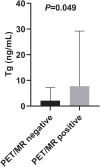Value of 18F-FDG Hybrid PET/MR in Differentiated Thyroid Cancer Patients with Negative 131I Whole-Body Scan and Elevated Thyroglobulin Levels
- PMID: 33824601
- PMCID: PMC8018385
- DOI: 10.2147/CMAR.S293005
Value of 18F-FDG Hybrid PET/MR in Differentiated Thyroid Cancer Patients with Negative 131I Whole-Body Scan and Elevated Thyroglobulin Levels
Abstract
Purpose: To evaluate the diagnostic performance of 18F-FDG PET/MR in detecting recurrent or metastatic disease in patients with differentiated thyroid cancer (DTC) who have increased thyroglobulin (Tg) levels but a negative 131I whole-body scan (WBS). The relationship between 18F-FDG PET/MR and serum Tg levels was explored. We also evaluated the therapeutic impact of PET/MR on patient clinical management.
Patients and methods: Twenty-nine DTC patients with a negative 131I-WBS of the last post-therapeutic and increased Tg levels under thyroid-stimulating hormone suppression treatment who underwent 18F-FDG PET/MR examination were retrospectively analyzed.
Results: Of those 29 patients, 18F-FDG PET/MR findings were true positive, true negative, false positive, and false negative in 18, 7, 2, and 2 patients, respectively. The overall sensitivity, specificity, and accuracy were 90.0%, 77.8%, and 86.2%, respectively. We noticed significant differences in serum Tg levels between the PET/MR-positive and PET/MR-negative patient groups (P=0.049). Receiver operating characteristic curve analysis showed that a Tg level of 2.4 ng/mL was the optimal cut-off value for predicting PET/MR results. The sensitivity, specificity, and accuracy of PET/MR were higher in patients with Tg levels greater than 2.4 ng/mL than in patients with lower levels. By detecting recurrent or metastatic disease, 18F-FDG PET/MR altered the clinical management in 7 patients (24.1%) of the overall population.
Conclusion: 18F-FDG PET/MR has high diagnostic accuracy for detecting recurrent or metastatic diseases in DTC patients and is useful for clinical management.
Keywords: 18F-FDG; PET/MR; differentiated thyroid cancer; thyroglobulin.
© 2021 Li et al.
Conflict of interest statement
The authors report no conflicts of interest in this work.
Figures




Similar articles
-
Value of Dedicated Head and Neck 18F-FDG PET/CT Protocol in Detecting Recurrent and Metastatic Lesions in Post-surgical Differentiated Thyroid Carcinoma Patients with High Serum Thyroglobulin Level and Negative 131I Whole-body Scan.Asia Ocean J Nucl Med Biol. 2016 Winter;4(1):12-18. doi: 10.7508/aojnmb.2016.04.003. Asia Ocean J Nucl Med Biol. 2016. PMID: 27904869 Free PMC article.
-
Correlation of 18F-FDG PET/CT findings with histopathological results in differentiated thyroid cancer patients who have increased thyroglobulin or antithyroglobulin antibody levels and negative 131I whole-body scan results.Clin Nucl Med. 2013 May;38(5):326-31. doi: 10.1097/RLU.0b013e318286827b. Clin Nucl Med. 2013. PMID: 23486319
-
The role of 18F-Fluorodeoxyglucose Positron Emission Tomography in patients with suspected recurrence or metastatic differentiated thyroid carcinoma with elevated serum thyroglobulin and negative I-131 whole body scan.Nucl Med Rev Cent East Eur. 2014;17(2):87-93. doi: 10.5603/NMR.2014.0023. Nucl Med Rev Cent East Eur. 2014. PMID: 25088108
-
Diagnostic performance of PET in thyroid cancer with elevated anti-Tg Ab.Endocr Relat Cancer. 2018 Jun;25(6):643-652. doi: 10.1530/ERC-17-0341. Epub 2018 Mar 20. Endocr Relat Cancer. 2018. PMID: 29559552
-
Match Point: Nuclear Medicine Imaging for Recurrent Thyroid Cancer in TENIS Syndrome-Systematic Review and Meta-Analysis.J Clin Med. 2024 Sep 10;13(18):5362. doi: 10.3390/jcm13185362. J Clin Med. 2024. PMID: 39336848 Free PMC article. Review.
Cited by
-
Prognostic Value of Hybrid PET/MR Imaging in Patients with Differentiated Thyroid Cancer.Cancers (Basel). 2022 Jun 15;14(12):2958. doi: 10.3390/cancers14122958. Cancers (Basel). 2022. PMID: 35740623 Free PMC article.
-
Diagnostic performance of whole-body [18F]FDG PET/MR in cancer M staging: A systematic review and meta-analysis.Eur Radiol. 2024 Jan;34(1):673-685. doi: 10.1007/s00330-023-10009-3. Epub 2023 Aug 3. Eur Radiol. 2024. PMID: 37535156
References
-
- Haugen BR, Alexander EK, Bible KC, et al. 2015 American thyroid association management guidelines for adult patients with thyroid nodules and differentiated thyroid cancer: the American thyroid association guidelines task force on thyroid nodules and differentiated thyroid cancer. Thyroid. 2016;26(1):1–133. doi:10.1089/thy.2015.0020 - DOI - PMC - PubMed
-
- Fatourechi V, Hay ID. Treating the patient with differentiated thyroid cancer with thyroglobulin-positive iodine-131 diagnostic scan-negative metastases: including comments on the role of serum thyroglobulin monitoring in tumor surveillance. Semin Nucl Med. 2000;30(2):107–114. doi:10.1053/nm.2000.4600 - DOI - PubMed
LinkOut - more resources
Full Text Sources
Other Literature Sources
Miscellaneous

